Working Condition Real-Time Monitoring Model of Lithium Ion Batteries Based on Distributed Parameter System and Single Particle Model
Ling Hung,Chng Yo.School of Electronic nd Informtion Engineering,Beijing Jiotong University,Beijing 100044,Chinb.Informtion Center,Ntionl Nturl Science Foundtion of Chin,Beijing 100085,Chin
Working Condition Real-Time Monitoring Model of Lithium Ion Batteries Based on Distributed Parameter System and Single Particle Model
Liang Huanga,Chang Yaob?
a.School of Electronic and Information Engineering,Beijing Jiaotong University,Beijing 100044,China
b.Information Center,National Natural Science Foundation of China,Beijing 100085,China
Lithium ion batteries are complicated distributed parameter systems that can be described preferably by partial differential equations and a field theory.To reduce the solution difficulty and the calculation amount,if a distributed parameter system is described by ordinary differential equations(ODE)during the analysis and the design of distributed parameter system,the reliability of the system description will be reduced,and the systemic errors will be introduced.Studies on working condition real-time monitoring can improve the security because the rechargeable LIBs are widely used in many electronic systems and electromechanical equipment.Single particle model(SPM)is the simplification of LIB under some approximations,and can estimate the working parameters of a LIB at the faster simulation speed.A LIB modelling algorithm based on PDEs and SPM is proposed to monitor the working condition of LIBs in real time.Although the lithium ion concentration is an unmeasurable distributed parameter in the anode of LIB,the working condition monitoring model can track the real time lithium ion concentration in the anode of LIB,and calculate the residual which is the difference between the ideal data and the measured data.A fault alarm can be triggered when the residual is beyond the preset threshold.A simulation example verifies that the effectiveness and the accuracy of the working condition real-time monitoring model of LIB based on PDEs and SPM.
Lithium ion battery,Distributed parameter system,Single particle model, Condition monitoring
I.INTRODUCTION
In a distributed parameter system(DPS)[1],state variables and controlled variables are influenced by time and space,such as fluid power system,heat transfer system,flexible spacecraft,and electromagnetic system[2]. The boundary conditions and the feedback interactions are very complicated in DPS,so DPS only can be described precisely by the field theory and partial differential equation(PDE)[3].It is hard to analyze,design, simulate,and diagnose DPSs.The lumped parameter systems[4]can usually be described by ordinary differential equation(ODEs)[5].But if ODEs are used to describe DPSs,the reliability of the system description is reduced because of the systemic errors.
With the increase of DPSs complexity and the safety requirement,the modelling simulation and the failure diagnosis[6]have become the hotspots and the difficulties in the research field of DPSs.Oh and Pantelides proposed a general modelling language for lumped parameter systems and DPSs based on integral,partial differential,and algebraic equations[7]. Ghantasala and El-Farra proposed a methodology of an integrated robust fault detection and isolation and fault-tolerant control architecture for distributed parameter systems modeled by nonlinear parabolic PDEs with time varying uncertain variables and actuator constraints[8]. Demetriou proposed a model-based fault detection technique and diagnosis scheme based on the finite dimensional results,and the fault detection technique is applied to the infinite dimensional dynamical systems and DPSs[9].Antonios Armaou proposed an adaptive detection observer with a time varying threshold,and the diagnostic observer provides the additional robustness with respecting to false declarations and minimizing fault detection time[10].In order to reduce the fault detection time and the calculation amount,ODEs are used to replace PDEs in some methods.These methods can render inaccurate description because ODEs neglect a significant portion of DPSs.If a failure happens in DPSs,the PDEs dynamics will be changed,the approximated ODEs models are more unreliable.
Lithium ion battery(LIB)[11]is used widely in digital products,electric automobiles,and electromechanical systems because rechargeable LIBs have a lot ofgood properties,such as high energy density,long cycle life,low self-discharge rate,and high working voltage.With the widespread applications of LIBs,a series of failures[12]about LIBs have appeared,for example,LIBs will lose energy storing capacity quickly or even burst into fire when being damaged or overcharged. The research on the working conditions real-time monitoring model of LIBs is crucial to the applications of LIBs.Chen et al.proposed an accurate and intuitive LIB model based on ODEs,and this model can predict both I-V performance and the battery run-time easily and quickly[13].Santhanagopalan et al.proposed a rigorous two dimensional model based on chemical reaction and ODEs,and this model can simulate the cycling performance of LIBs and predicts the potential as a function time[14].Moura proposed an adaptive LIBs observer based on linear PDE and the electrochemical model,and this observer can estimate state-of-charge and state-of-health of LIBs[15].Schmidt et al.proposed an electrochemical LIB model based on classical single particle model(SPM)and lumped parameter nonlinear model,and this model can predict the terminal voltages for arbitrary loads and potent iostatic operation[16]. LIBs are regarded as DPSs in this work,PDEs and SPM are combined to a LIB modelling algorithm.LIBs can be described preferably and quickly by the LIB modelling algorithm.The working conditions of LIBs can be monitored in real time.A simulation experiment shows that the lithium ion concentration in the anode of LIB and the residual between the ideal value and the measured value can be tracked steadily and effectively by the working condition monitoring model.
?Author to whom correspondence should be addressed.E-mail: cyao@bjtu.edu.cn
II.FAULT DESCRIPTION OF DPS
The basic expression form of the standard parabolic PDE:
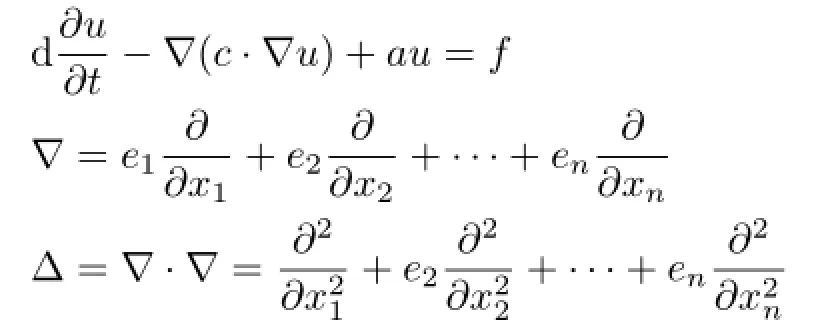
The initial condition is u0=u(t0). The standard parabolic PDE is used to describe nonlinear DPS:

Where x is the system state,the time t>0.The coordinate z∈(0,1).The coefficient ζ1>0.s(z)is the smooth function.The boundary conditions:

Where ζ2is the coefficient.u(t)is the control input of the system when z=1.If the output signal is measured under the same actuation condition,then y(t)=x(1,t). Supposing f(z,t,y(t))is the fault function,the fault DPS can be described by PDE:

Where E(τ)is the fault error function changing over time,E(τ)=E(t?t0)and E(τ)∈(0,1).ˉf is the fault coefficient.The system has no fault before t0:E(τ)=0, τ<0. The fault level increases gradually after t0: E(τ)=1?e?kτ,τ≥0.Where k is the coefficient of fault changing rate.The bigger k is,the faster the increasing speed of system fault is.
III.WORKING CONDITIONS MONITORING MODEL
The working conditions monitoring model can track the real-time parameters of DPS,and calculate the residual between the monitoring data and the ideal data. The failure alarm will be triggered when the residual is beyond the threshold stored in the monitoring model.Eq.(1)and Eq.(2)are combined with the Luenberger observer to describe the DPS in the ideal state:

The boundary conditions:


The boundary conditions:

When DPS is working in the normal state,the system residualand the output residualis within the normal tolerance range.In Eq.(7),the system residual?x can be described in Eq.(9).

Where T is the sampling interval that the output signal y(t)is measured by the working condition monitor. Supposing the output signal y is unchanging between the samplings interval T,and the current time is t,thenthe output signal y is measured at t+kT(k=0,1,2,...). Eq.(9)is plugged into Eq.(7)and Eq.(8):

The boundary conditions:

Where ζ3is the user defined coefficient that can keep DPS stable,and ζ3>0[17].Leibniz integral rule is used to substitute Eq.(10),DPS without failure can be described:

Leibniz integral rule is used to substitute Eq.(11):

So the boundary conditions:
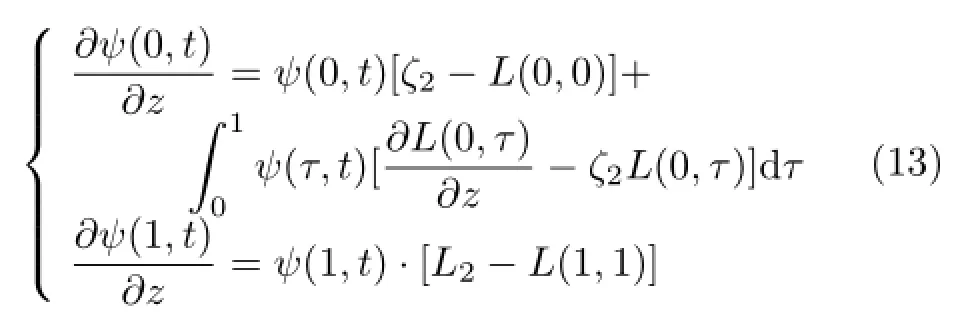
DPS described in Eq.(10)and Eq.(11)is equivalent to DPS described in Eq.(12)and Eq.(13).The following conditions can be obtained by solving simultaneous equations Eq.(10)?Eq.(13).

The boundary conditions:

The regulation coefficients:

PDE has the unique solution when the boundary conditions described in Eq.(15)can be satisfied in DPS described in Eq.(14).Because Eq.(14)?Eq.(16)are irrelevant to time,the solutions can be solved before working conditions monitor. In conclusion,DPS working in the normal state can be described in Eq.(1)and Eq.(2).DPS working in the fault state can be described in Eq.(3)and Eq.(4).DPS working in the ideal state can be described in Eq.(5) and Eq.(6).The residual between the actual DPS state and the ideal DPS state can be described in Eq.(7) and Eq.(8).The regulation coefficients can be given in Eq.(16).According to Eq.(3)and Eq.(5),DPS working in the fault state can be approximated:


The boundary conditions of Eq.(19)are shown as Eq.(8).is the residual of the unknown parameters.is the residual of the system state.is the output residual.DPS is judged as the fault system when the output residual is beyond the threshold preset in the monitoring model.
IV.WORKING CONDITIONS MONITORING SYSTEM OF LIB
COMSOL multiphysics Software[18]and MATLAB PDE Toolkit[19,20]are combined to build the working conditions real-time monitoring model of LIB based on PDEs and SPM.
SPM of LIB is shown as Fig.1.SPM assumes that the limitations posed by the solution phase of the battery cell are negligible.Each electrode is represented by a single spherical particle whose area is equal to the active area of the solid phase in the porous electrode.The solution phase is not considered during the model equations are developed.SPM is further simplified when the concentration within the sphere is approximated by a parabolic profile.The solid phase concentration is represented by a second order polynomial whose coefficients are expressed in terms of the average concentration and the concentration at the sphere surface.SPM of LIB can be described by the PDEs, for anode

The boundary conditions:

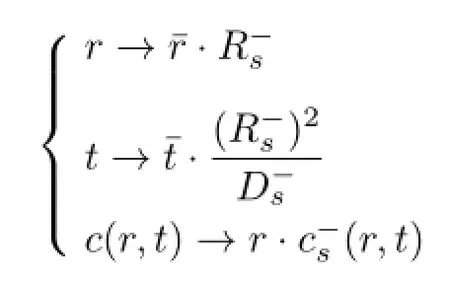
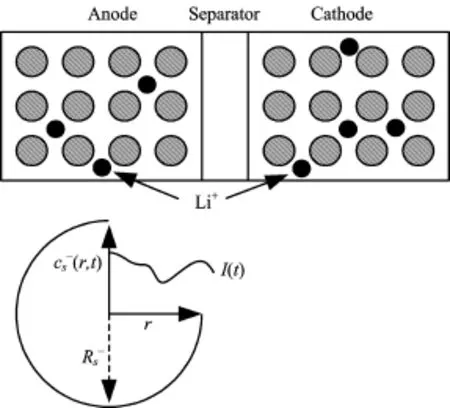
FIG.1 SPM of LIB.

LIB working in the ideal state can be described by the form of Eq.(3).

The boundary conditions:

c(1,t)can be regarded as a function of the output voltage because only the output voltage is measurable.A failure is supposed to happen in LIB at the time t=60 s:

The fault degree of LIB will be more and more serious when t>60 s.The working conditions of LIB working in the fault state can be estimated by the proposed PDE model:

The boundary conditions:

where c(1,t)??c(1,t)is the residual between the ideal value and the actual value of lithium ion concentrationin the anode of LIB.L1and L2can be numerically solved from PDE defined in Eqs.(14)?(16).The coefficients are defined:ζ1=1,ζ3=2 during the simulation. The sampling interval of the working condition monitor is T=1 s.There are three input signals in the working condition monitor:the input current I(t),lithium ion concentration in the anode c(1,t),and the working condition of the last second.The ideal lithium ion concentration in the anode is shown as Fig.2.The input current of LIB is shown in Fig.3.
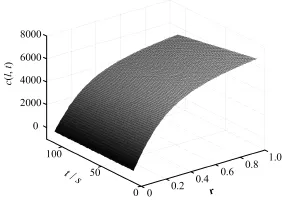
FIG.2 Ideal lithium ion concentration in the anode.

FIG.3 Input current I(t)of the simulation.
Lithium ion concentration in the anode of LIB willchange obviously when a failure happens.So the residual between the monitoring lithium ion concentration and the ideal lithium ion concentration can be used to monitor the working condition of LIB.The bigger the residual is, the bigger the failure is.The simulation results of the residual monitor are shown in Fig.4.
The simulation results of the working condition realtime monitoring can be seen from Fig.4.LIB works in the normal state when t<60 s,so the residual of lithium ion concentration in the anode is tiny.A failure happens in LIB at t=60 s.The failure degree of LIB is more and more serious when t>60 s,so the concentration residual begins to increase gradually.The alarm threshold is preset at 6 mol/m3.The concentration residual is beyond the threshold at t=90 s approximatively.
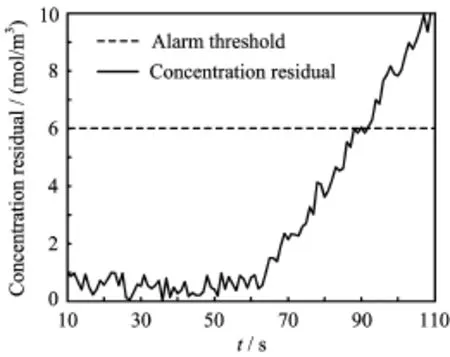
FIG.4 Working condition monitoring results.
V.CONCLUSION
A lithium ion battery modelling approach based on partial differential equations and single particle model is proposed to monitor the working condition of lithium ion battery in real time.Firstly,lithium ion battery is regarded as distributed parameter system,and partial differential equations are used to describe distributed parameter system preferably.Secondly,a lithium ion battery model is constructed by single particle model to monitor the working condition of lithium ion battery. Thirdly,the lithium ion concentration in the anode of LIB and the residual between the ideal value and the measured value are tracked by the working condition monitoring model,then the fault alarm can be triggered when the residual is beyond the preset threshold.The simulation example verifies that the effectiveness and the accuracy of the working condition real-time monitoring model of lithium ion battery based on single particle model and partial differential equations.
VI.ACKNOWLEDGMENTS
This work was supported by the National Natural Science Foundation of China(No.61575035)and the Specialized Research Fund for the Doctoral Program of Higher Education of China(No.20130009120042).
[1]H.Deng,M.Jiang,and C.Q.Huang,J.Process Control 22,404(2012).
[2]M.P.Kummer,J.J.Abbott,B.E.Kratochvil,R. Borer,A.Sengul,and B.J.Nelson,IEEE Trans.Rob. 26,1006(2010).
[3]L.Huang and J.Y.Li,Acta Phys.Sin.64,108202 (2015).
[4]W.Pawlus and H.R.Karimi,J.Mechanical Sci.Technol.25,1737(2011).
[5]A.Amini-Harandi and H.Emami,Nonlinear Anal.Theory Methods Appl.72,2238(2010).
[6]L.Huang,J.J.Hou,Y.Liu,and Y.Guo,Chin.J. Electronics 22,615(2013).
[7]M.Oh and C.C.Pantelides,Comput.Chem.Eng.20, 611(1996).
[8]S.Ghantasala and N.H.El-Farra,Automatica 45,2368 (2009).
[9]M.A.Demetriou,ESAIM 7,43(2002).
[10]A.Armaou and M.A.Demetriou,AIChE J.54,2651 (2008).
[11]J.W.Fergus,J.Power Sources 195,939(2010).
[12]W.Chen,W.T.Chen,M.Saif,M.F.Li,and H.Wu, IEEE Trans.Control Syst.Technol.22,290(2013).
[13]M.Chen and G.A.Rincon-Mora,IEEE Trans.Energy Convers.21,504(2006).
[14]S.Santhanagopalan,Q.Guo,P.Ramadass,and R.E. White,J.Power Sources 156,620(2006).
[15]S.J.Moura,N.A.Chaturvedi,and M.Krstic,J.Dyn. Syst.Meas.Control 136,011015(2014).
[16]A.P.Schmidt,M.Bitzer,A.W.Imre,and L.Guzzella, J.Power Sources 195,5071(2010).
[17]K.Yuan,H.X.Li,and J.D.Cao,IEEE Trans.Fuzzy Syst.16,567(2008).
[18]L.Cai and R.E.White,J.Power Sources 196,5985 (2011).
[19]B.Y.Jia,D.W.Hu,B.Z.Xie,K.Dong,and H.Liu, Biosens.Bioelectron.41,894(2013).
[20]A.V.Wouwer,P.Saucez,and W.E.Schiesser,Ind. Eng.Chem.Res.43,3469(2004).
[21]C.De Las Casas and W.Z.Li,J.Power Sources 208, 74(2012).
[22]W.J.Zhang,J.Power Sources 196,13(2011).
(Dated:Received on April 1,2016;Accepted on May 9,2016)
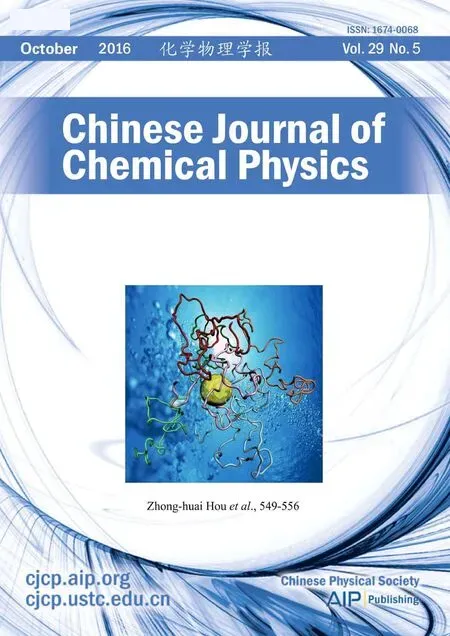 CHINESE JOURNAL OF CHEMICAL PHYSICS2016年5期
CHINESE JOURNAL OF CHEMICAL PHYSICS2016年5期
- CHINESE JOURNAL OF CHEMICAL PHYSICS的其它文章
- Preparation of Bio-hydrogen and Bio-fuels from Lignocellulosic Biomass Pyrolysis-Oil
- Combination Computing of Support Vector Machine,Support Vector Regression and Molecular Docking for Potential Cytochrome P450 1A2 Inhibitors
- Hydrodeoxygenation of Anisole over Ni/α-Al2O3Catalyst
- Highly Efficient and Selective Removal of Pb(II)ions by Sulfur-Containing Calcium Phosphate Nanoparticles
- Efficient Removal Phenol Red over Ternary Heterostructured Ag-Bi2MoO6/BiPO4Composite Photocatalyst
- Photo-depositing Ru and RuO2on Anatase TiO2Nanosheets as Co-catalysts for Photocatalytic O2Evolution from Water Oxidation
